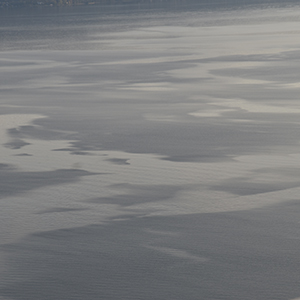Effects of natural surfactants on the spatial variability of surface water temperature under intermittent light winds on Lake Geneva

Accepted: 31 May 2022
HTML: 125
All claims expressed in this article are solely those of the authors and do not necessarily represent those of their affiliated organizations, or those of the publisher, the editors and the reviewers. Any product that may be evaluated in this article or claim that may be made by its manufacturer is not guaranteed or endorsed by the publisher.
Authors
The spatial variability of lake surface water temperature (LSWT) between smooth and rough surface areas and its potential association with the natural surfactant distribution in the surface microlayer were investigated for the first time in a lake. In spring 2019, two different field campaigns were carried out in Lake Geneva to measure: i) the enrichment factor of fluorescent dissolved organic matter (FDOM) as a proxy for biogenic surfactants, and ii) LSWT and near-surface water temperature profiles while simultaneously monitoring water surface roughness in both cases. Results indicate that, under intense incoming short-wave radiation and intermittent light wind conditions, the atmospheric boundary layer (ABL) was stable and the accumulation of heat due to short-wave radiation in near-surface waters was greater than heat losses by surface cooling, thus creating a diurnal warm layer with strong thermal stratification in the water near-surface layer. A threshold wind speed of 1.5 m s-1 was determined as a transition between different dynamic regimes. For winds just above 1.5 m s-1, the lake surface became patchy, and smooth surface areas (slicks) were more enriched with FDOM than rough areas (non-slick) covered with gravity-capillary waves (GCW). Sharp thermal boundaries appeared between smooth and rough areas. LSWT in smooth slicks was found to be more than 1.5°C warmer than in rough non-slick areas, which differs from previous observations in oceans that reported a slight temperature reduction inside slicks. Upon the formation of GCW in non-slick areas, the near-surface stratification was destroyed and the surface temperature was reduced. Furthermore, winds above 1.5 m s-1 continuously fragmented slicks causing a rapid spatial redistribution of LSWT patterns mainly aligned with the wind. For wind speeds below 1.5 m s‑1 the surface was smooth, no well-developed GCW were observed, LSWT differences were small, and strong near-surface stratification was established. These results contribute to the understanding and the quantification of air-water exchange processes, which are presently lacking for stable Atmospheric Boundary Layer conditions in lakes.
Edited by
Marco Toffolon, Department of Civil, Environmentaland Mechanical Engineering, University of Trento, ItalyHow to Cite

This work is licensed under a Creative Commons Attribution-NonCommercial 4.0 International License.
Similar Articles
- Christine Fritz, Katja Kuhwald, Thomas Schneider, Juergen Geist, Natascha Oppelt, Sentinel-2 for mapping the spatio-temporal development of submerged aquatic vegetation at Lake Starnberg (Germany) , Journal of Limnology: Vol. 78 No. 1 (2019)
- Thomas C. Jensen, Winter decrease of zooplankton abundance and biomass in subalpine oligotrophic Lake Atnsjøen (SE Norway) , Journal of Limnology: Vol. 78 No. 3 (2019)
- Michael SCHAGERL, Irene DROZDOWSKI, David G. ANGELER, Thomas HEIN, Stefan PREINER, Water age – a major factor controlling phytoplankton community structure in a reconnected dynamic floodplain (Danube, Regelsbrunn, Austria) , Journal of Limnology: Vol. 68 No. 2 (2009)
- Celine TESSIER, Antonia CATTANEO, Bernadette PINEL-ALLOUL, Gaetano GALANTI, Giuseppe MORABITO, Biomass, composition and size structure of invertebrate communities associated to different types of aquatic vegetation during summer in Lago di Candia (Italy) , Journal of Limnology: Vol. 63 No. 2 (2004)
- Hans Bernd STICH, Martin PFEIFFER, Gerhard MAIER, Zooplankton communities in a large prealpine lake, Lake Constance: comparison between the Upper and the Lower Lake , Journal of Limnology: Vol. 64 No. 2 (2005)
- Enrico Bonatti, Hutchinson’s tree , Journal of Limnology: Vol. 80 No. 3 (2021): Celebratory Issue - 80th Anniversary of the Journal of Limnology
- Matti Leppäranta, Elisa Lindgren, Lijuan Wen, Georgiy Kirillin, Ice cover decay and heat balance in Lake Kilpisjärvi in Arctic tundra , Journal of Limnology: Vol. 78 No. 2 (2019)
- Marcela BASTIDAS NAVARRO, Beatriz MODENUTTI, UVR induce optical changes and phosphorous release of lake water and macrophyte leachates in shallow Andean lakes , Journal of Limnology: Vol. 69 No. 1 (2010)
- Walter AMBROSETTI, Luigi BARBANTI, Physical limnology of Italian lakes. 1. Relationship between morphometry and heat content , Journal of Limnology: Vol. 61 No. 2 (2002)
- Ambrosius J.M. Dörr, Antonia C. Elia, Marinella Rodolfi, Laura Garzoli, Anna M. Picco, Manuela D'Amen, Massimilaino Scalici, A model of co-occurrence: segregation and aggregation patterns in the mycoflora of the crayfish Procambarus clarkii in Lake Trasimeno (central Italy) , Journal of Limnology: Vol. 71 No. 1 (2012)
<< < 56 57 58 59 60 61 62 63 64 65 > >>
You may also start an advanced similarity search for this article.
-
Seyed Mahmood Hamze-Ziabari, Mehrshad Foroughan, Ulrich Lemmin, David Andrew BarryRemote Sensing : 2022
-
Mehrshad Foroughan, Seyed Mahmood Hamze‐Ziabari, Ulrich Lemmin, David Andrew BarryGeophysical Research Letters : 2022

 https://doi.org/10.4081/jlimnol.2022.2048
https://doi.org/10.4081/jlimnol.2022.2048





